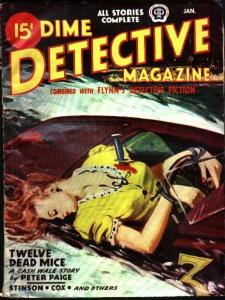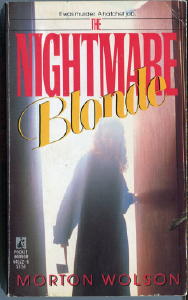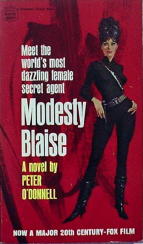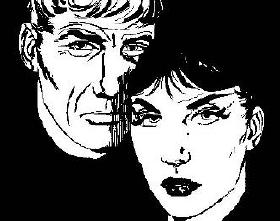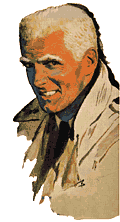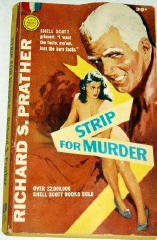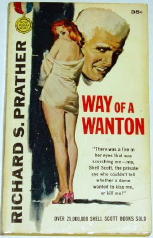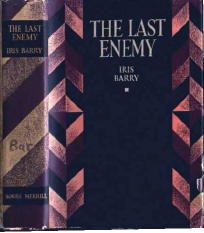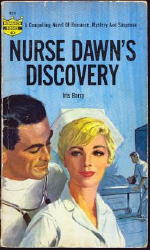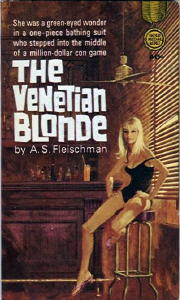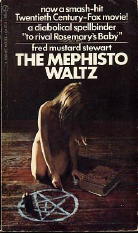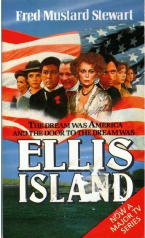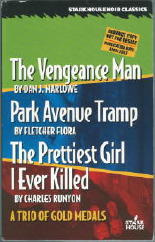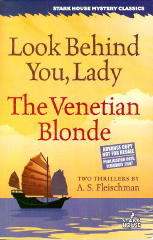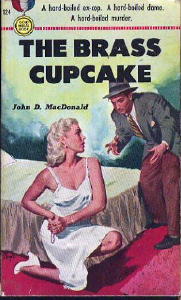February 2007
Monthly Archive
Mon 19 Feb 2007
MYSTERY SERIES CHARACTERS: FROM THE PRINTED PAGE TO TELEVISION
– Addenda and Corrections, by Marvin Lachman.
The primary list appeared on the original Mystery*File website in five parts:
CORRECTION– Ashdown, Clifford (joint pseudonym of R. Austin Freeman and John James Pitcairn).
NEW– Ashe, Gordon (pseudonym of John Creasey). On April 30, 1962 on the American series Thriller, there was an episode, “The Specialists,” that was based on the Ashe series about PATRICK DAWLISH, though the lead character, played by Lin McCarthy, had his name changed to Peter Duncan.
CORRECTION– Biggers, Earl Derr. The name of the series was The New Adventures of Charlie Chan.
NEW– Buchan, John. Hannay was a 1988 British series, with Robert Powell as RICHARD HANNAY. Powell had previously played Hannay in a 1978 film remake of The 39 Steps.
ADDITION– Chandler, Raymond. Danny Glover played Marlowe in the adaptation of the short story “Red Wind” in the Fallen Angels series on November 26, 1995. In the 1998 TV movie Poodle Springs, based on the novel which Robert B. Parker completed from material left by Chandler, James Caan was Marlowe.
ADDITION– Charteris, Leslie. Ivor Dean was INSPECTOR TEAL to Moore’s Templar. Simon Dutton was Simon Templar in a British series of six TV movies under the umbrella heading of Mystery Wheel of Adventure in 1989.
CORRECTION AND ADDITION– Christie, Agatha. Regarding the series with Joan Hickson as Jane Marple, eliminate the word “Mystery!” and change the title of the first show to The Body in the Library. David Horovitch played DETECTIVE INSPECTOR SLACK on that show. Harry Andrews was SUPT. BATTLE in The Seven Dials Mystery which aired in Britain on Mobil Showcase on April 16, 1981. Philip Jackson was CHIEF INSPECTOR JAPP during the series in which David Suchet played Poirot.
NEW– Cody, Liza. ANNA LEE was played by Imogen Stubbs in a 1995 series aired in the U.S. on the A & E network.
NEW– Deighton, Len. Ian Holm was BERNARD SAMSON in Game, Set, and Match, a 1988 TV series based on Deighton’s trilogy.
ADDITION– Dexter, Colin. Kevin Whateley continued his role from the Inspector Morse series, albeit with a promotion, as INSPECTOR LEWIS in the 2006 TV movie of that title.
ADDITION– Fair, A.A. (Pseudonym of Erle Stanley Gardner). In 1959 a U.S. TV pilot film starred Billy Pearson as DONALD LAM and Benay Venuta as BERTHA COOL.
NEW– Gould, Chester. His DICK TRACY was played by Ralph Byrd (who had played him in the movies) in a 1950-1951 American series.
NEW– Hamilton, Nan. ISAMU (“SAM”) OHARA was played by Pat Morita in a 13-episode American series in 1987-1988.
NEW– Holton, Leonard (pseudonym of Leonard Patrick O’Connor Wibberly). George Kennedy was Father Samuel Cavanaugh in the 1971-1972 American series Sarge. According to William L. De Andrea because of similarities to Holton’s books about FATHER JOSEPH BREDDER, a royalty was paid to the writer while Sarge was aired.
NEW– Hornung, E.W. His RAFFLES was played by Anthony Valentine in a 1977 series for Yorkshire TV in England.
ADDITION– James, P.D. CORDELIA GRAY was played by Helen Baxendale in An Unsuitable Job for a Woman on Mystery! in 2000.
ADDITION– McBain, Ed. There was also a 1995 TV movie, Lightning, about the 87th Precinct, with Randy Quaid as Steve Carella, Alex MacArthur as Bert Kling, Ving Rhames as Artie Brown, Alan Blumenfeld as Ollie Weeks, and Ron Perkins as Meyer Meyer.
CORRECTION– Murphy, Warren and Sapir, Richard. The name of the actor who played Remo Williams was Jeffrey Meek, not Jeffrey Weeks.
ADDITION– O’Donnell, Peter. In 1982 ABC in the U.S. made an hour-long pilot film with Ann Turkel as MODESTY BLAISE and Lewis Van Bergen as WILLIE GARVIN.
ADDITION– Orczy, Baroness. Anthony Andrews was SIR PERCY BLAKENEY, aka THE SCARLET PIMPERNEL in a 1982 British TV movie The Scarlet Pimpernel.
ADDITION– Parker, Robert B. Robert Urich starred in several Spenser for Hire TV movies after the series ended, and then he was replaced by Joe Mantegna. Avery Brooks starred in his own TV series, A Man Called Hawk, on ABC in 1988-1989. One of Parker’s more recent character, POLICE CHIEF JESSE STONE has been played by Tom Selleck in two TV movies, Night Passage and Stone Cold. Polly Shannon played attorney ABBY TAYLOR.
ADDITION– Peters, Ellis (pseudonym of Edith Pargeter). Tom Lowell played DOMINIC FELSE in the adaptation of her Edgar-winning novel Death and the Joyful Woman on the Alfred Hitchcock Hour, April 12, 1963.
ADDITION– Quarry, Nick (pseudonym of Marvin H. Albert). Though NICK QUARRY was not a series character in the books Albert wrote as “Quarry,” there was a 1968 TV pilot film, based on Albert’s work, starring Tony Scotti as Nick Quarry.
ADDITION– Rankin, Ian. Ken Stott replaced Hannah as Rebus.
NEW– Reichs, Kathy. Emily Deschanel is DR. TEMPERANCE BRENNAN in the current (2005- ) TV series Bones.
NEW– Rogers, Samuel. Ralph Roberts was PAUL HATFIELD in “Don’t Look Behind You,” an episode on the Alfred Hitchcock Hour Sept. 27, 1962.
ADDITION– Sayers, Dorothy L. Richard Morant played Bunter during the 1980s.
ADDITION– Simenon, Georges. Jean Richard played Maigret in a French TV series c.1970.
ADDITION– Smith, Martin (Cruz). Ron Leibman was ROMAN GREY in The Art of Crime, a 1975 TV movie based on his novel Gypsy in Amber.
ADDITION– Spillane, Mickey. Rob Estes was Mike Hammer in the TV movie Deader Than Ever (1996).
NEW– Stevenson, Richard. Chad Allen played his DONALD STRACHEY in two TV movies Third Man Out (2005) and Shock to the System (2006) aired on the Here! Network.
ADDITION– Stout, Rex. Also on the 2001 series, Colin Fox was FRITZ BRENNER; Kari Matchett was LILY ROWAN; Conrad Dunn was SAUL PANZER; Saul Rubinek was LON COHEN; Trent McMullen was ORRIE CATHER; R.D. Reid was SGT. PURLEY STEBBINS; Ken Kramer was DR. VOLLMER; and Fulvio Cecere was FRED DURKIN.
NEW– Thomas, Leslie. Peter Davison, who also had played Albert Campion, was “DANGEROUS” DAVIES in the British series The Last Detective, based on Thomas’s book.
NEW– Valin, Jonathan. Gil Gerard played HARRY STONER in the 1989 TV movie Final Notice, based on Valin’s novel.
NEW– Vickers, Roy. His main series is THE DEPARTMENT OF DEAD ENDS. There are several detectives in this branch, most often Inspector Rason. However, in “The Crocodile Case,” which appeared on Alfred Hitchcock Presents on May 25, 1958, the detective is INSPECTOR KARSLAKE, played by John Alderson. In “The Impromptu Murder,” on the same show on June 22, 1958, it is Robert Douglas as INSPECTOR TARRANT.
ADDITION– Wallace, Edgar. Hugh Burden played the title role of J.G. REEDER in The Mind of Mr. J.G. Reeder, a series for Thames Television in England 1969-1971. He also was one of the writers.
NEW– Willis, Ted. Jack Warner played P.C. GEORGE DIXON in Dixon of Dock Street, a popular British series that ran from 1955 through 1976. Dixon first appeared in Willis’s 1950 novel The Blue Lamp.
NEW– Yates, Dornford. In She Fell Among Thieves, originally on BBC2’s “Play of the Week” in 1978, Malcolm McDowell was RICHARD CHANDOS SMITH and Michael Jayston was MANSEL.
Mon 19 Feb 2007
MORTON WOLSON – The Nightmare Blonde
Pocket, paperback original; 1st printing, April 1988.
This book escaped a lot of notice when it came out, or at least that’s what I strongly suspect. Reading just the cover and the blurb at the top – “It was murder. A Hatchet Job.” – I think the average reader would have thought that this was just another horror novel of the blood and gore variety, both of which were very popular at the time. Nor would the name of the author have meant anything to anybody.
But what if I told you that Morton Wolson was the real name of 1940s pulp writer Peter Paige, creator of the private detective Cash Wale? Or at least I think that Wale was a PI, but I may be wrong and someone will have to tell me.
In any case, Peter Paige wrote a slew of detective stories for magazines like Black Mask, Detective Fiction Weekly and Dime Detective – mostly the latter, I believe – until disappearing from sight about the same time as most of the pulps died, in the early 1950s. Most of them were, by all accounts, fairly ordinary. Paige is a not a name which comes to many people’s mind when it comes to pulp detective fiction. Myself, I know the name, and I know Cash Wale, his primary series character, but as far as any single story is concerned, I can’t think of a single plot line, I have to say, and reluctantly so as I do.
When I asked veteran researcher Victor Berch to see what he could come up with as far as either Paige or Wolson was concerned, he did his usual amazing sleight-of-hand and came up with a couple of interesting items. In the Los Angeles Times of January 7, 1946, there was a short item with the following headline: Writer, Held for Beating Wife, Says She Beat Him:
Morton Wolson, 32, detective story writer under the name of Peter Paige, was in the San Pedro Jail yesterday facing a charge of wife beating… Mrs. Wolson [Ruth, age 23] charged that he husband struck her in the face during an argument… Wolson, in jail … denied the charges and declared that he was merely trying to defend himself.
Accompanying the article, not much longer than the excerpt above, are separate photos of both Wolson and his wife, who is shown feeding their baby with a bottle. (The headline of the item that follows on the same page is: Jeanne Crain and Mother Reconciled.)
Besides the work he did for the pulps as Peter Paige, Wolson had two stories published under his own name. The first one appeared in the January 1954 issue of EQMM, a tale entitled “The Attacker,” and a little bit later, “The Glass Room,” was published in the September 1957 issue.
Wolson’s output may have been small under his own name, but “The Attacker” was good enough to be selected in David C. Cooke’s annual Best Detective Stories of the Year anthology for 1954, and more than that, to be picked up again by Allen J. Hubin’s Best of the Best Detective Stories: 25th Anniversary Collection in 1971. (Al did not remember this fact while he and I were corresponding a short while ago about Wolson, until I pointed it out to him.)
There is one entry for Wolson on www.imdb.com. A story he wrote was the basis for “Prime Suspect,” an episode of Jane Wyman Presents the Fireside Theater, telecast on 27 February 1958. A gent named Steve Fisher did the adaptation, and an actress named Nita Talbot appeared in it, whom I thought was tremendously good-looking at the time; the leading role was played by William Bendix, whom hardly anybody thought was good-looking at any time. Where the story may have been published earlier remains unknown.
The next time Victor came across Wolson’s name in a newspaper was in the New York Times for March 29, 1970, in an advertisement for a special “Manager’s” sale being held by Furniture-in-the-Raw, an outfit with five stores in the New York City area. I’ll quote the relevant detail:
Our Queens store mgr. Morton Wolson says “If it doesn’t sell at these prices it can’t be sold.”
Nothing more seems to have put Wolson in the news or in any sort of spotlight until the publication of The Nightmare Blonde in 1988, and then, as I alluded to earlier, the book seems to have come and gone without much notice. At the moment there seems to be two copies available on the Internet, one from Alibris in the $3.00 range, and one from England in the $30 range. It is dedicated to his wife Gaye, so it is clear that the earlier one did not last.
But before getting to the main event, perhaps you’ve started to wonder. Wolson was born in 1913 (making his age as reported in the LA Times correct), and he died in 2003. You also may be beginning to wonder about this book he wrote in 1988, when he was 75, and whether it is any good or not.
My answer, in a word, is “yes,” but if I may, I’d also have to say that it’s a qualified response, and I’ll get to that soon. Remember now that it was marketed as a horror novel, which in a strong but not overpowering sense it is, as the murder to be solved is that of a family of four, killed by someone with a very sharp axe.
But what it really, really is, when you really get down to it, is a detective novel in a very traditional sense. It’s also a tough, middle-class sort of novel, and hard-boiled at about the same level as, for example, a Ross Macdonald novel, not to forget to mention that it’s quite definitely noirish in a way as well.
Let me explain that last sentence right away. Dan Warden, the leading character, is the former chief of police in Oregon City, a town somewhere along the Pacific Ocean where the story takes place, who had recently been fired for beating up a newspaper columnist’s nephew and being chewed out in print by that very same newspaper columnist. After coming out of a 24-hour drinking binge, about which he remembers nothing, he discovers that it is (no surprise here) the newspaper columnist who has been murdered, along with the three remaining members of his family.
Which makes Dan Warden the number one suspect, no matter how close his friendship with the police commissioner is. At the same time as Warden is discovering how badly his life has been suddenly turned upside down and inside out, he makes a friend – saving her life, to be precise, as she (a blonde) tries jumping off the end of Fisherman’s Wharf, but miscalculating badly as she does so. Allow me to insert a long quote right about here, taken from pages 17 and 18:
“I’m really all right,” she said. “The problem was not being able to talk it out. There was nobody I could really talk to. I had to keep it inside me. Like a nightmare that wouldn’t leave me alone. Do you know what I’m trying to say?”
“Sure,” Dan said, his arm around her waist, urging her along. For the first time he realized that she had a slender, almost lithe, waist, and he felt a tug of sexual excitement, followed by a flush of shame that he should even note such a thing in this vulnerable woman. “I know,” he said. “It’s like you couldn’t get out of the mirror.”
They were moving very slowly. She put her face against his chest and through the fabric said, “Do you know what it’s like to be two people? I mean two separate people — and one doesn’t know what the other is thinking or doing except in dreams now and then, and you don’t understand the dreams?”
“I know all about it,” he told the droplets in her blond hair.
Her eyes probed his.
“Don’t joke with me, please!”
“Scout’s honor,” he said, urging her toward Bayfront Street. “Me, I just had a twenty-four hour memory gap. And while I can remember staring at myself in a lot of bar mirrors, and awakening once on a strange back porch the other side of town, and seeing a sudden blinding flash of light, and walking several hundred miles through this rain, I have no idea where I left my hat or coat or parked my Chevy, or who I punched, or who punched and scratched me. I have not even the dimmest idea of even seeing the man I’m supposed to have either punched to death or killed with a hatchet.”
Kay Mullins (that’s her name) has had psychological problems dealing with children in the past, and now two of them are dead, and the reason for emphasizing that she is a blonde, as I did a just a moment ago, is that several blonde hairs have been found at the scene of the murders.
It takes Dan most of the rest of the book to investigate the crimes while trying to stay ahead of the new police chief, who still considers him to be his primary suspect, while keeping Kay stable and discovering just how many blondes just happened to be in and around the area of the victims’ home, including Kay herself.
Part of the investigation includes visiting a camp of the local branch of the White Knights of America and at least three brothels of increasing degrees of sophistication, and some low spots as well. It’s a tough, rough story at times, and while it tends to start rambling a little, it still provides about four hours of pure entertainment, or at least it did for me, flawed only – here comes a qualifier – by the inescapable unlikelihood of one too many fairly uncommon events, all happening at the same time and in the same place.
But while the laws of probabilities, still enforced in every state in the union, say that the juxtaposition of so many blondes in one focal point of chaos, could not and should not have happened, what Wolson does is not easy. He makes the book flow well enough, and smoothly enough, that you (the reader) don’t (and can’t) stop to think about it while you’re in the process of reading, and read it you will.
As the identity of the killer becomes increasingly clear, and Wolson does a more than creditable job in disguising the solution to the murders for as long as he can – and even longer than he had a right to, truth be said – the chills begin as well, intellectually as well as (without trying to give anything away) deep down inside the reader’s bones somewhere.
Nor is the book over even then. For noir fans everywhere, lift a glass to a pulp writer past. This one’s for you.
— written in September 2006
UPDATE: Victor Berch has come up with some more information on Wolson’s life. Why don’t I simply let him have the floor:
“About the only thing I can add are some vital statistics: Morton Wolson was born the son of Joseph and Zina Wolson on June 9, 1913 in New York. He died January 4, 2003 in Laguna Hills, CA. Might have been living in Mission Viejo as that seems to be the latest phone record. At the time of his death, he was married to a woman named Gaye (last maiden name unknown). She was born February 1, 1927 and died Aug 30, 2005. It is highly possible that Morton was not his original name as he is listed in the 1920 US Census as Mortimer. He may have thought that was too sissified of a name and decided to call himself Morton, which is the name he used for Social Security purposes. Oh, his parents were immigrants from Russia. He also had a brother, Robert.”
Sat 17 Feb 2007
The title of the first Modesty Blaise novel was exactly that, Modesty Blaise, published by Souvenir Press in 1965. The author was Peter O’Donnell. Modesty, of course, had appeared even earlier, as her adventures in book form were preceded by those in the daily comic strips, debuting in the London Evening Standard in 1963. The first artist for the strip was Jim Holdaway, then Romero and a small number of others, with Romero returning before O’Donnell decided to end it in 2001.
The comic strip was not widely distributed in the US, in part because adventure strips find very little acceptance in this country in general, but also because of the nude scenes which had to be censored. A favorite tactic that Modesty used against her foes was called the “Nailer,” whereby she would strip above the waist and Willlie Garvin, her companion in crime-fighting, would take advantage of the distraction she caused. Not a technique that could be shown in the US!
There were movies, too, not always very successful, and perhaps I’ll discuss them someday. A pilot was made and aired for proposed TV series starring Ann Turkel, but nothing further developed.
Taken from wikipedia, here are portions of a couple of paragraphs that will help explain some of the background for Modesty Blaise, the character.
“In 1945 a nameless girl escaped from a displaced person (DP) camp in Karylos, Greece. She did not remember anything from her short past. She wandered through post-WW2 Mediterranean and Arabia. During these years she learned to survive the hard way. She befriended another wandering refugee, a Hungarian scholar named Lob who gave her an education and a name: Modesty Blaise. Eventually she took control of a criminal gang in Tangier and expanded it to international status as “The Network.”
“During these years she met Willie Garvin. Despite the desperate life he was living, she saw his potential and offered him a job. Inspired by her belief in him, he pulled through as her right-hand man in The Network and became Modesty Blaise’s most trusted friend. Theirs is a strictly platonic relationship and is based on mutual respect and shared interests. They have never gone to bed with each other, fearing that would ruin their special bond.
“When she felt she’d made enough money, she retired and moved to England; Willie Garvin followed suit. Bored by their new lives among the idle rich, they accepted a request for assistance from Sir Gerald Tarrant, a high-ranking official of the British secret service — and this is where the story really begins.”
Now go, if you will, to the Crime Time website , and an interview with Mr. O’Donnell, where he explains for the first time who it was — the real person — upon whom Modesty Blaise was based.
Here I’ll quote only the last paragraph, in which Mr. O’Donnell says:
“I am in debt to the child I saw that day in 1942, both for the privilege of having met her, however briefly, and for her providing the role model for a character I have now written about for close on 40 years. I still think of her from time to time, and wonder what became of her. If alive today, she would have just turned 70. Whatever the length of her days, I can only hope that she was granted some measure of the reward she deserved for her courage and spirit. I salute her.”
–Thanks to Peter Rozovsky of Detectives Without Borders for the tipoff to the interview.
Fri 16 Feb 2007
It didn’t take long for the news to get around. James Reasoner, Ed Gorman and Bill Crider were among the first to have gotten the news of Mr. Prather’s death online, but I’d heard it from Al Hubin by way of John Herrington (in England) just minutes before I saw it on Bill’s blog. It must be true, and yet it’s still hard to believe.
I’m not positive, but I’m all but convinced that it was one of Shell Scott’s crazy capers in the mid-1950s that introduced me to Gold Medal paperback fiction. I’d been reading the Hardy Boys before that, as I’ve related before, and while the details of what happened when are not exactly clear, I know it wasn’t much earlier that I’d started in on the shelf of Erle Stanley Gardner hardcovers I’d discovered in the Cadillac (MI) public library.
Perry Mason was nothing like Shell Scott, a private eye with a leer and not much savoir faire, and there was no going back. My innocence was gone. No, I didn’t abandon Perry. I read those, too, the entire shelf. But I also read all of those paperbacks with the yellow spines in the supermarket spinner rack, with new books in every Wednesday, or was it Tuesday, on my way home from high school, some of them while standing right there at the rack, as who had 75 cents to spend whenever another three of them came out?
Mr. Prather came up for discussion on this blog not too long ago, when I mentioned the interview that Linda Pendleton did with him late last year, and I suggest that you go read it again. You did read it the first time, didn’t you?
Here’s his entry in Allen J. Hubin’s Crime Fiction IV, in chronological order. I won’t list all of the reprints, of which there were many: n = novel, co = collection, ss = short story, nv = novelette, na = novella; SS = Shell Scott.
PRATHER, RICHARD S(cott) (1921- )
* Case of the Vanishing Beauty (n.) Gold Medal 1950 [SS]
* Bodies in Bedlam (n.) Gold Medal 1951 [SS]
* Everybody Had a Gun (n.) Gold Medal 1951 [SS]
* Find This Woman (n.) Gold Medal 1951 [SS]
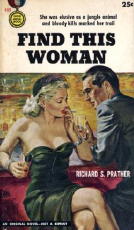
* Dagger of Flesh (n.) Falcon 1952
* Darling, It’s Death (n.) Gold Medal 1952 [SS]
* Lie Down, Killer (n.) Lion 1952 [SS]
* Way of a Wanton (n.) Gold Medal 1952 [SS]
* Ride a High Horse (n.) Gold Medal 1953. Also published as: Too Many Crooks. Gold Medal, 1956. [SS]
* Always Leave ’Em Dying (n.) Gold Medal 1954 [SS]
* Pattern for Panic (n.) Abelard-Schuman 1954. Revised version, with SS: Gold Medal, 1961.
* Strip for Murder (n.) Gold Medal 1956 [SS]
* Too Many Crooks (n.) Gold Medal 1956; See: Ride a High Horse (Gold Medal, 1953).
* The Wailing Frail (n.) Gold Medal 1956 [SS]
* Have Gat – Will Travel (co) Gold Medal 1957 [SS]
# • The Build-Up • ss Suspect Feb ’56
# • Code 197 • ss Manhunt Jun ’55
# • Murder’s Strip Tease • ss
# • Sinner’s Alley • ss
# • The Sleeper Caper • ss Manhunt Mar ’53
# • Trouble Shooter • ss Accused Jan ’56
* Three’s a Shroud (co) Gold Medal 1957 [SS]
# • Blood Ballot • nv Menace Nov ’54
# • Dead Give-Away • na
# • Hot-Rock Rumble • nv Manhunt Jun ’53
* The Scrambled Yeggs (n.) Gold Medal 1958; See: Pattern for Murder (Graphic 1952), as by David Knight. [SS]
* Slab Happy (n.) Gold Medal 1958 [SS]
* Take a Murder, Darling (n.) Gold Medal 1958 [SS]
* Double in Trouble [with Stephen Marlowe] (n.) Gold Medal 1959 [SS with Chester Drum]
* Over Her Dear Body (n.) Gold Medal 1959 [SS]
* Dance with the Dead (n.) Gold Medal 1960 [SS].
* Dig That Crazy Grave (n.) Gold Medal 1961 [SS]
* Shell Scott’s Seven Slaughters (co) Gold Medal 1961 [SS]
# • Babes, Bodies and Bullets • ss
# • The Best Motive • ss Manhunt Jan ’53
# • Butcher • ss Manhunt Jun ’54
# • Crime of Passion • ss
# • The Double Take • nv Manhunt Jul ’53
# • Film Strip • nv Ed McBains Mystery Book #1 ’60
# • Squeeze Play • ss Manhunt Oct ’53
* Kill the Clown (n.) Gold Medal 1962 [SS]
* Dead Heat (n.) Pocket Books 1963 [SS]
* The Peddler (n.) Gold Medal 1963; See: Lion, 1952 as by Douglas Ring.
* The Cockeyed Corpse (n.) Gold Medal 1964 [SS]
* Joker in the Deck (n.) Gold Medal 1964 [SS]
* The Trojan Hearse (n.) Pocket Books 1964 [SS]
* Dead Man’s Walk (n.) Pocket Books 1965 [SS]
* Kill Him Twice (n.) Pocket Books 1965 [SS]
* The Meandering Corpse (n.) Trident 1965 [SS]
* The Kubla Khan Caper (n.) Trident 1966 [SS]
* Gat Heat (n.) Trident 1967 [SS]
* The Cheim Manuscript (n.) Pocket Books 1969 [SS]
* Kill Me Tomorrow (n.) Pocket Books 1969 [SS]
* The Shell Scott Sampler (co) Pocket Books 1969 [SS]
# • The Bawdy Beautiful • ss
# • The Cautious Killers • ss Shell Scott Mystery Magazine Nov ’66
# • The Da Vinci Affair • ss Shell Scott Mystery Magazine Feb ’66
# • The Guilty Party • ss Come Seven/Come Death, ed. Henry Morrison, Pocket, 1965
# • The Live Ones • ss, 1956
* Dead-Bang (n.) Pocket Books 1971 [SS]
* The Sweet Ride (n.) Pocket Books 1972 [SS]
* The Sure Thing (n.) Pocket Books 1975 [SS]
* The Amber Effect (n.) Tor 1986 [SS]
* Shellshock (n.) Tor 1987 [SS]
* Hot-Rock Rumble and The Double Take (co) Gryphon Books 1995
# • The Double Take [Shell Scott] • nv Manhunt Jul ’53
# • Hot-Rock Rumble [Shell Scott] • nv Manhunt Jun ’53
as by KNIGHT, DAVID
* Pattern for Murder (n.) Graphic 1952. Also published as: The Scrambled Yeggs, as by Richard S. Prather. Gold Medal, 1958. [SS]
* Dragnet: Case No. 561 (n.) Pocket Books 1956 [TV tie-in]
as by RING, DOUGLAS
* The Peddler (Lion, 1952, pb) Reprinted as by Richard Prather: Gold Medal, 1963.
I’ve omitted some of Mr. Prather’s stories that haven’t appeared in any of the various collections. I’ll have to add those later. It’s quite a list of fiction even without them. Many of these books I have not read in over 50 years, and the plots are mostly gone from memory – not all: no one who’s read Strip for Murder will ever forget what went on in that one – but not the days at the paperback rack at the local supermarket.
I’ll close up this tribute for tonight with a review of the Scott Scott mini-epic which I read most recently. It’s from November 2002:
RICHARD S. PRATHER – Way of a Wanton
Gold Medal 497; c.1952; 4th GM printing, July 1957
Prather was not one of the Gold Medal authors Gorman mentioned in the book before this one [a book entitled Will You Still Love Me Tomorrow?] — Sam McCain seems to have been primarily a Harry Whittington fan — but the Shell Scott books are very much a part of my high school memories. Not that I remember actually reading one, straight through, from beginning to end, but — ah — the good parts, those I remember.
This particular one, the inimitable private eye’s sixth, gets Shell involved with the movie business. There is a small but not insignificant body of work that mixes gumshoes with starlets, and this one’s a good addition to the group. Invited to a rather raucous Hollywood party — you might even call it wanton — Prather does — Shell breaks up the gathering when he retrieves a dead female body from the pool.
Those at the party — all of whom are suspects — are working on a Grade B jungle epic, which means lots of good-looking women in skimpy costumes, and Shell outdoes himself in leering and ogling and all-around having a good time.
And so does the reader. Back in the 1950s, this was hot stuff. According the cover, over 10 million Prather books had been sold. Much to my surprise, however, I have to tell you that Mr. Scott is a fraud. Given two skinny-dipping opportunities, confronted with ladies already disrobed or on their way so, Shell Scott hems and haws and gulps and swallows, and man — he stalls. Just like all of the adolescent kids reading the books. A lot of talk and imagination, and not nearly as much action as they’d like to let on.
Prather has a nice way with words, though, in a purely soft-boiled vein, and the detective work is at least adequate, even though Shell has to admit, with 14 pages to go, that he’d “narrowed it down to the world.” Back in the 50s, however, to repeat a phrase, nobody read these books for the feats of detection they contained, and they still don’t today.
COMMENT [02-18-07]: From an email from Bill Pronzini:
I hadn’t heard about Prather until your e-mail. Not unexpected, at his age, but sad news nonetheless. Shell Scott was my favorite character is an impressionable kid, and like you, Prather was the writer who turned me on to the pleasures of other Gold Medal original writers — John D., Charles Williams, Peter Rabe, etc. I must have reread WAY OF WANTON and my all-time favorite Shell Scott, STRIP FOR MURDER, half a dozen times as a teenager. The novels don’t quite hold up for me now, but I can still derive a chuckle and considerable enjoyment from some scenes and such passages as “You’re won’t believe this, boss, but that rock just shot me in the ass!” (THE COCKEYED CORPSE).
Wed 14 Feb 2007
While Allen Hubin has closed the book, so to speak, at the year 2000 for his encyclopedic bibliography of the mystery field, now in its Fourth Edition, Crime Fiction IV: A Comprehensive Bibliography, 1749-2000, additions and corrections continue to be made. You can follow the progress of this Addenda by checking in every so often at the website I?m maintaining for it at www.crimefictioniv.com. At the present time there are 10 installments of the Addenda, and material is quickly accumulating for Part #11.
These additions and corrections can come from almost any source. As new reference works become available, they?re scoured to see if they have additional information that’s relevant. New websites pop up every day, and when mystery-related, their information must be checked out.
But sometimes it?s a matter of someone browsing through the present edition, looking at a particular author’s entry, finding it interesting for one reason or another, and deciding to check him or her out.
Here?s the entry for a relatively obscure author in the current CFIV, with the books listed chronologically. I haven’t double-checked to be sure, but I?m relatively confident that this is the way it has looked for at least several editions. You be the detective.
BARRY, IRIS (1895-1969)
* -The Last Enemy (n.) Bobbs 1929
* Here Is Thy Victory (n.) Mathews 1930; See: The Last Enemy (Bobbs 1929).
* The Mandura Mystery (n.) Hale 1966
* The House of Deadly Night (n.) Belmont 1970 [Oregon]
* Seven Guests of Fear (n.) Hale 1970
* The Unprotected (n.) Berkley 1973
* The Darkness at Mantia (n.) Berkley 1974 [Washington (state)]
Once your attention is focused on this list of Ms. Barry’s books, you should see what John Herrington saw. Sometimes a mystery writer will have a second career, so to speak, later in life, but to have four of the five books in this second spurt of books not appear until after your death, well, at least it warrants some investigation.
I’ll let Al continue the story. Here’s what happened after John asked him about this apparent anomaly in the career of Iris Barry:
“I did some digging and found that the University of Oregon Library had some of her papers. I contacted the Library and they provided a list of titles for which they had manuscripts (a few apparently never published), which did not include that early (1929) book. So I suspected that there were two Iris Barry’s at work, and when I found that one (with different dates from CFIV) had died in Oregon, it looked like I might have a hit. So I e-mailed the library near her reported death and for $15 they were willing to hunt for an obituary and send me a photocopy. Thus were my suspicions confirmed, with the results shown in [Part 10 of the Addenda]. (I was confident enough that I put the information in #10 even before the obit came). By the way, as I recall, the first Iris Barry also wrote some other books (about film people).”
Here’s how the revised entries for the two authors now look. Note that in tracking down the details, one additional book now also appears in the second Iris Barry?s listing.
BARRY, IRIS. 1895-1969. Ref: CA. (Corrected entry.)
Here Is Thy Victory; see The Last Enemy
-The Last Enemy. Bobbs, 1929. British title: Here Is Thy Victory. Mathews, 1930
BARRY, IRIS (THORPE). 1903-1983. (Titles moved here from above author entry.)
The Darkness at Mantia. Berkley, 1974 [Washington]
The House of Deadly Night. Belmont, 1970 [Oregon]
The Mandura Mystery. Hale, 1966
Nurse Dawn’s Discovery. Monarch, 1964
Seven Guests of Fear. Hale, 1970
The Unprotected. Berkley, 1973; Remploy, 1974
Here’s a description of The Last Enemy, written by Iris Barry #1. You can see why it’s indicated as having only marginal crime content. My impression is that it’s almost science-fictional in nature:
“Mr. Griffiths, the old registrar of Hallam, England notices that no natural deaths are being reported in his county. Similar reports drift in from other counties as it becomes certain that people are no longer dying naturally anywhere in the whole South of England. Murder and suicide are on the increase as elderly people begin to feel uncomfortable for without deaths where are property inheritances? Births are still occuring normally and visions of food shortages will be the result where before they had always depended upon death to keep life in balance.”
One the books about film people that Al mentions that Iris Barry #1 wrote is:
D.W. Griffith: American Film Master. The Museum of Modern Art, New York, 1940. Pictorial Paper-covered Boards. No. 1 in the Museum of Modern Art Film Library Series, in an edition of 8000 copies.
On the other hand, the books of Iris Barry #2 were written as novels of “romantic suspense” if not as gothic romances, the heyday for which was exactly the period in which they appeared. Two of them are in my Gothics collection, in fact, catalogued online at https://mysteryfile.com/Gothics.html.
Wed 14 Feb 2007
Posted by Steve under
PublishersNo Comments
Hello Steve:
Here’s what’s coming up for 2007 from Stark House:
January
JIMBO / THE EDUCATION OF UNCLE PAUL by Algernon Blackwood. New intro by Mike Ashley. Two supernatural novels set in the world of children but written for adults.
February
A TRIO OF GOLD MEDALS (details of which you already have)
PAN’S GARDEN / INCREDIBLE ADVENTURES by Algernon Blackwood. Intros by Mike Ashley and Tim Lebbon. Previously published in separate volumes, two of Blackwood’s best story collections in one volume.
March
THE OLD BATTLE-AX / DARK POWER by Elisabeth Sanxay Holding. Intro by Gregory Shepard. Two classic novels of suspense, the latter of which has never appeared before in paperback in its complete edition.
April
UNDERGROUND / COLLECTED STORIES by Russell James. Intro by the author. James’s first novel published here in the U.S. for the first time, along with seven previously uncollected stories, one of which has never been published before.
May
A SHOT IN THE DARK / SHELL GAME by Richard Powell. Intro to be determined. Two slyly written mysteries from the author of The Philadelphian, recently reprinted by Plexus Publishing.
June
SNOWBOUND / GAMES by Bill Pronzini. Two excruciating novels of suspense, too long out of print. Intro to be determined but hopefully to include something from Bill himself.
July
THE KILLER / DEVIL ON TWO STICKS by Wade Miller. Two fine 50’s thrillers from from Bob Wade and Bill Miller, authors of the the Max Thursday detective series.
August
DOGTOWN / SOULTOWN by Mercedes Lambert. Lambert in real life was Douglas Anne Munson, who died a few years ago from cancer. She left behind three excellent, cynical mysteries featuring lawyer-turned-sleuth Whitney Logan and her streetwise sidekick Lupe Ramos–these two books were the only ones to be published in her lifetime, out of print now for the past ten years.
September
SWEET MONEY GIRL / LIFE & DEATH OF A TOUGH GUY by Benjamin Appel. Intro by Carla Appel. Two gritty novels from the New York streets, the former of which is one of Appel’s only two Gold Medal books.
October
ANATOMY OF A KILLER / A SHROUD FOR JESSO by Peter Rabe. Two more dryly written gangster novels from one of the best of the noir writers of the 50’s and 60’s.
November
A DEVIL FOR O’SHAUGNESSY / THREE-WAY SPLIT by Gil Brewer. The big news for 2007 is that Stark House will be publishing a Brewer novel that never appeared during the author’s lifetime, a fast-paced noir from the early 60’s. We couldn’t be more excited!
December
IT’S ALWAYS FOUR O’CLOCK / IRON MAN by W. R. Burnett. The first novel is a jazz story originally written as by James Updyke, the second a marvelous tale of the rise and fall of a prizefighter. Both feature Burnett’s keen eye for characterization and dialog, and neither have appeared in paperback before.
And so the year goes out with a bang (assuming I keep to the schedule!). All books will be $19.95 except for the TRIO book, which is $23.95.
I hope this information is helpful. I could probably say more about each book, but wanted to keep it brief. Don’t have intros determined for each book yet. Already planning for another Harry Whittington in 2008, and hopefully more Douglas Sanderson, Vin Packer and Gil Brewer as well.
And you will notice, not everything is vintage-50’s this year. The Lambert is an experiment, I will admit. Something on the order of “righting a wrong,” if you will.
Anyway, thanks for all your support, Steve.
Cheers,
Greg
Tue 13 Feb 2007
Posted by Steve under
Authors ,
ReviewsNo Comments
A. S. FLEISCHMAN – Look Behind You Lady
Gold Medal 223; paperback original. First printing, February 1952; 2nd printing, Gold Medal 572, 1956. Hardcover reprint: Herbert Jenkins, UK, 1962, as Chinese Crimson. To be published by Stark House Press in late 2006 as a trade paperback combined with The Venetian Blonde.
Albert Sidney Fleischman, known to his friends and colleagues as Sid, was born in 1920, and at 86, thankfully he’s still around to see publisher Greg Shepard bring a couple of his old Gold Medal paperbacks back into print.
His career in the adult mystery field was relatively short, beginning with a couple of Phoenix Press mysteries in 1948 and 1949, then shifting to Gold Medal for five paperback originals between 1951 and 1963, with one from Ace making an appearance in 1954.
After that he became an author of children’s books, winning the Newberry Medal for The Whipping Boy (1987), and the creator of Bullwhip Griffin – the movie about his adventures was based on the book By The Great Horn Spoon (1963).
Greg always does a great job in adding material to his books about the authors he publishes, so I won’t try to come up with any more background like this on my own. Nor will I say anything about The Venetian Blonde, one of my favorite mystery titles of all time, and I love the cover as well – they go hand-in-hand together as one truly great match-up.
To introduce you to Look Behind You Lady (no comma, and I’m not sure why), you might pretend that you’re at the newsstand in 1952, or the drug-store spinner rack, and you’d see the cover, designed to catch anyone’s eye, 100% guaranteed. (Truth be told, I was 10 at the time, so it had to have been the 1956 reprint that snagged my attention.)
Then once in the would-be purchaser’s hand, he would have looked inside the front cover to read the following blurb:
She dipped the coal of the cigarette in the water and it died with a thin sizzle. Then she rose from the tub like a mermaid, turning her back to me, and held her arms up. I wrapped the towel around her, sarong-like. Her hands closely softly over mine as I tucked in a corner.
“I was mad at you when you walked out,” she whispered, “but I like the way you walked back in.”
I turned her around and kissed her lips.
“You’re getting wet,” she said.
“Stop talking,” I said.
Not a word wasted, and if you could pass this up, you’re a better person than I, or your tastes are so different from mine that you should be reading another review anyway.
But just in case a quarter was all that you had in your pocket, back in 1952, and you needed just that one extra nudge to tip the balance toward paying the storekeeper and on your way with the book, all you would have had to do was to turn two more pages and start reading from the top of Chapter One:
She said, “May I sit down?”
I looked up from my vinho e licores at the girl standing beside my table. I was on the marble terrace of the Hotel China Seas in Macao, killing time between shows, and feeling a little surly. Along the hotel wall a Filipino swing band was giving the week-enders from Hong Kong something to dance to.
“Talking to me?” I muttered.
“Talking to you,” she said.
She was wearing a smart white dress, and her dark hair was cut short, with bangs. I didn’t like the bangs. The dress had a mandarin collar, which was a shame, because a plunging neckline would have been something worth plunging for.
“You can sit down,” I said. “I was just leaving.”
“Please –”
I looked at her and smiled only to myself. Sure, I thought, there’s not much paradise left in the Orient, but there’s Macao. Don’t bring your wife unless you’re just interested in the view from the old Portuguese fort on the hill. Macao attracts the finest tramps in the world, its streets are paved with gold, and gambling is a way of life. If you can’t enjoy yourself in Macao, there’s something wrong with you – not Macao. Or you brought your life.
“Look,” I said. “Is every woman in Macao on the make? Every time I buy myself a drink some girl comes along and wants to muscle in on the act.”
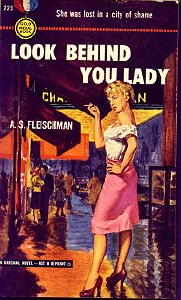
Ka-ching! Sold, am I right, or am I right? If you can’t read this story and hear the voices of Humphrey Bogart as rather world-weary stage magician Bruce Flemish and Lauren Bacall as Donna Van Deerlin, the lady above who has both a room number and a proposition for him, you haven’t been watching as many of the movies of the 1940s and early 1950s as is good for you. Something’s been missing from your video diet that you ought to remedy as soon as possible.
More. The owner of the Hotel China Seas is Senhor Gonsalves, a gentleman who is missing both his thumbs, and he also has a small task for Flemish to perform as part of his act, a task involving the not-so-small sum of $10,000 Hong Kong dollars. Sydney Greenstreet.
One of Senhor Gonsalves’ many assistants is a mousy sort of fellow named Josef Nakov, who is handy with a gun. Peter Lorre.
From page 144:
I was on my feet now and had a cigarette going in my fingers. Gilberto held Donna’s arms behind her. Phebe sat on the edge of the bed, like an outcast, her head buried in her hands. Nakov held a fresh, big gun and looked supremely happy. “O.K.,” I said, “so you’re going to murder us.”
“We can find another word,” Gonsalves said, his hands stuck in his pockets. “Eliminate. Murder is for your Chicago gangsters. In politics, we eliminate. It is death on a higher social level.”
“We’ll appreciate the difference,” I said, “but why bother? We’re not very clear on what the hell your game is. You must be getting damned scared to want to murder everyone in sight.”
Nakov says something about the intelligence of Donna, who had walked back into Gonsalves’ hands after a brief escape.
I turned on Gonsalves angrily. “Make him shut up,” I said. “If he licks your boots once more in public, I’ll puke.”
You can cast Gilberto, young punk working for Gonsalves, and Phebe, a somewhat shopworn stripper whose act follows that of Flemish on stage, yourself.
The plot has something to do with the Communist Reds and/or the opium trade, and it matters not very much in the long run. But there are twists to be had, and thrills of the nature above, and what more could you want of a book of exotic Oriental danger and intrigue like this?
–written in September 2006.
Mon 12 Feb 2007
Unlikely to be recognized as a crime fiction novelist by many, even perhaps by himself, author Fred Mustard Stewart died last Wednesday at his home in Manhattan.
His entry in Allen J. Hubin’s Crime Fiction IV is admittedly meager, but it’s certainly enough to warrant a tribute here. (Thanks to the comment left by his nephew Brough Stewart, his year of birth has been corrected to 1932 from 1936, as was originally given.)
STEWART, FRED MUSTARD (1932-2007)
* * The Mephisto Waltz (Coward, 1969, hc) [New York City, NY] Joseph, 1969. Film: TCF, 1971 (scw: Ben Maddow; dir: Paul Wendkos).
* * -The Methuselah Enzyme (Arbor, 1970, hc) [Switzerland] Joseph, 1971.
* * -A Rage Against Heaven (Viking, 1978, hc) [1800s] Hutchinson, 1978.
Regarding that one definite entry (the dashes indicating that the other two are only marginally crime-related), his obituary in the New York Times goes on to say:
“Originally trained as a concert pianist, Mr. Stewart drew on this background for his first novel,
The Mephisto Waltz (Coward-McCann), published in 1969. (The publicity materials for the book included a 45-r.p.m. recording of Mr. Stewart playing the title piece, by Liszt.) In 1971, the book became a film with Alan Alda as a young writer whose body is usurped by an aging pianist.”
The last line gives it all away. The tale should be be categorized more precisely as a horror novel, more related to Rosemary’s Baby than to Sherlock Holmes — and to be sure both the book and the film based upon it were marketed that way.
From the archives of the New York Times, here are the opening sentences of a review written by Howard Thompson, published April 10, 1971:
“Shift
Rosemary’s Baby to California, with the nice young couple abruptly exposed to some chic, jet-set zombies, including the world’s greatest pianist. When this old demon dies, the husband acquires both his soul and pianistic genius, pounding out Liszt to prove it.
“The sensible wife, who squares off early with the old musician’s horrible dog, expects and gets the worst, with a couple of murders. Add some angular photography and a spooky, haunted-house score …”
A complete bibliography for Mr. Stewart can be found online here. He will perhaps be best remembered for what the Times calls his “multi-strand family narratives,” of which one entitled Ellis Island (Morrow, 1983) may be as representative as any. The novel follows the lives of “five young penniless people who came to America at the turn of the century — a land of shining hope and breathtaking challenge. They came to fulfill a glowing promise and take the fearful gamble of a new life in a land where anything was possible.”
Ellis Island was made into a television mini-series on CBS in 1984, a Golden Globe winner for Faye Dunaway (Best Supporting Actress) and recipient of several Emmy nominations.
Mon 12 Feb 2007
It’s a good thing that Bill Crider reads this blog. If you saw his comment on my post about trying to remember where I’d seen a photo of mystery writer Dan J. Marlowe recently, you already know that even though he is somewhat older than I am, his mind is at least twice as sharp.
You’ll find a photo on the back of the upcoming collection from Stark House Press in which one of his books is going to be reprinted, Bill said. And so it is.
And where is my copy of the ARC for this book? On the top of the pile of TBR books on the living room coffee table. I think I need a shorter leash, no doubt about it!
While I was on the hunt, Greg Shepard and Mark Shepard, a couple of the head guys at Stark House, sent me photos of the cover of their upcoming book, from which I’ve uploaded the images that you see here.
Contained in the book, coming out in April, 2007, are three novels published by Gold Medal back in the era when Gold Medal was THE publisher of tough, noirish, hard-boiled fiction, bar none:
THE VENGEANCE MAN, Dan J. Marlowe (Gold Medal d1645, 1966)
PARK AVENUE TRAMP, Fletcher Flora (Gold Medal 781, 1958)
THE PRETTIEST GIRL I EVER KILLED, Charles Runyon (Gold Medal k1507, 1965)
Well, maybe these are a little past Gold Medal’s prime in the era, but they’re still gritter and tougher than anything else published at the time, and if this is the kind of mystery and crime fiction that you prefer to read, take my word for it, you aren’t going to go wrong reading any of the three.
Quite coincidentally, in today’s mail came my contributor’s copy of a two-in-one combo of stories by A. S. “Sid” Fleischman, Look Behind You Lady [+] The Venetian Blonde, also from Stark House Press.
I wrote the introduction to the first book, based on a review I did of the book, and unbeknownst to me at the time, Mr. Fleischman, now in his late 80s, wrote an overall one for both. Luckily the two introductory essays seem to mesh together very well.
I’ll post the review as a separate blog entry, coming up soon, and in the meantime, I’ll check in with Greg Shepard and see if I can’t have him say something about what’s in store from Stark House for the rest of the year.
As for Dan J. Marlowe, to get back to the original inquiry, why not check out Josef Hoffman’s piece about him, “Playing with Fire,” quoted on the back cover next to the photo at the top of this page. You’ll find the article reprinted online at the old M*F website, along with a short essay on Marlowe’s Gold Medal fiction by Bill Crider, along with a bibliography of all of his book-length fiction. Recommended!
Mon 12 Feb 2007
Hi Steve,
I just read an internet article you wrote some time back on John D. MacDonald. I first became acquainted with his work while serving in Vietnam long ago. Little did I know then that later on I would be a high school English teacher, and as such, I have always thought that MacDonald was one of the most overlooked authors in American literature. Do you know of any teaching resources that were ever developed for any of MacDonald’s works?
Thanks,
Chris Creasman
Hi Chris
And thanks for the inquiry. I didn’t write the article you’re referring to, though — you must be referring to the interview that Ed Gorman did with JDM which I published on the original M*F website. (And no, no one’s come up with the name of the writer who MacDonald accused of plagiarizing him, not even his son Maynard.) Even though I haven’t read any of his books in a while, and shame on me, I always thought he was a fine writer.
As for teaching resources, I found this link, but it seems fairly meager to me. Maybe someone else knows more than I do, though, and if you do, I hope you’ll let us know about it. –Steve
PS. I’ve shown only one of JDM’s covers here. For a slide show of over 100 of them, check out this page put together by Bill Crider.
« Previous Page — Next Page »
